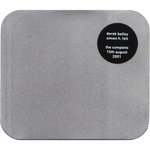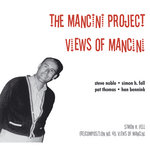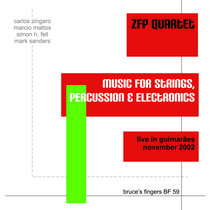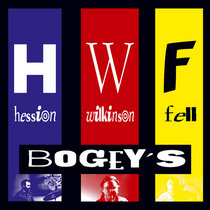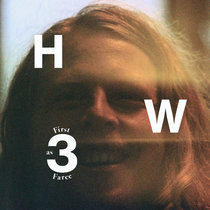
The Hearing Continues
by London Improvisers Orchestra
-
Compact Disc (CD)2001 double CD release, in jewel box with 24-page booklet.
[Shipping prices are for airmail/priority delivery]ships out within 2 days€15.75 EUR or more
-
Compact Disc (CD)The same as the above, but without the jewel box.
If you have no need of the somewhat unloved and increasingly old-fashioned jewel box, we will send you the discs and all paper parts from the CD, without the plastic box.
The price is the same (we don't really need any more empty jewel boxes!), but it should offer you significant savings on shipping, especially if you order several discs and/or are outside Europe.ships out within 2 days€15.75 EUR or more
-
Subscription
Subscribe now to receive all the new music Bruce's Fingers creates, including 5 back-catalog releases, delivered instantly to you via the Bandcamp app for iOS and Android. You’ll also get access to subscriber-only exclusives. Learn more.Subscribe Now €20 EUR/year or more
-
full score: Morton's Mobile
1. |
|
about
This second London Improvisers Orchestra recording includes several free improvisations, plus conducted pieces and compositions for improvisers by Steve Beresford, Evan Parker, Dave Tucker, Veryan Weston, Caroline Kraabel, Phil Wachsmann, Alex Ward, Knut Aufermann, Pat Thomas, David Leahy & Simon Fell (his Composition No. 53 - Morton's Mobile)
---------- press quotes ----------
"Warning: People afraid of experimenting and not so open minded will be horrified by this music. I take my hat off in front of this group of musicians that can go through experimental tunes like Proceeding 3 (wave like sounds) or Concert for Soft-Loud-Key-Box to name just a couple of tunes. Another thing that amazed me is the use that this musicians do of silences (an overlooked factor in most musicians) and dynamics, despite being so many people in the orchestra. Open your mind and enjoy this new offering from this selection of amazing musicians." MUSIC EXTREME
"What this phenomenal gathering of reed players (11), string players (11), pianists (3), percussionists (4), brass players (4), along with various members playing electronics, bamboo pipes, and "objects (some amplified)" offers is a group of open-minded, adventurous artists who are committed to exploring new strategies for large-scale improvisation in a truly orchestral setting. They are certainly an orchestra that dives in headfirst to collective, spontaneous large-group explorations as documented on Proceeding 3 and Proceeding 4 which kick off each CD of this set. These are complexly nuanced interactions full of dynamic modulations that seem next to impossible considering the overwhelming number of participants. Yet they pull it off with impressive collective interplay. But this orchestra also provides a striking, expanded setting for the members to explore compositional frameworks for improvisation. Of course with musicians like these, compositional frameworks take on all sorts of guises. A few highlights include Alex Ward's How Can You Delude Yourself?, a piece with two instructions that constantly cancel each other out, the ensemble thrown into a dynamic hyper-awareness as the music leaps and lurches around with needlepoint give-and-take until a collective conclusion almost magically emerges. Simon Fell's Morton's Mobile takes its inspiration from Morton Feldman, and serves to focus around specific sustained chords drawing out an extended sense of harmonic shading and subtly gradated, hovering momentum. Dave Tucker's Red Rose Theme says more about the theme of spontaneously conducted improvisation than it does about thematic material as the foundation of a composition, with its caterwauling sections for Hans Koch's contrabass clarinet, the woody chalmeau of Alex Ward's clarinet, and the grumbled textures of Alan Tomlinson's trombone tumbling over Adam Bohman's 'scraped objects'. Knut Aufermann's Birthday Piece revolves around the use of numbered cards as a cueing device. This leads to a constantly shifting transition between sub-groupings of players that ought to be disjointed mayhem but ends up being a study in detailed, conversational pointillism. In lesser hands, these compositional strategies could come off as mere contrivance. Instead, they serve as fertile springboards for collective discovery. Two pieces for smaller group improvisations provide a chance to focus on particular sections of the orchestra. Dingos Creep for saxophone sextet (Tom Chant, Evan Parker, Caroline Kraabel, Adrian Northover, John Butcher and Garry Todd) bring a compositional sense to the six-way spontaneous interaction as the six horns weave a web of lace-like delicacy. Lines criss-cross and slowly converge on hovering chords, only to arch off again with tightrope control that only comes from the most unwavering attention. Music for Pianos, Percussion & Harp offers the unique opportunity to hear the piano interactions of Pat Thomas, Steve Beresford, and Veryan Weston with harpist Rhodri Davies joined by percussionists Mark Sanders, Louis Moholo, Tony Marsh, and Steve Noble. The piece evolves as a masterful study in textures and contrasts. Throughout, the crystalline studio recording captures every subtlety while managing to create a sense of the musicians filling the room with sound. So in the end, an Improvisers Orchestra provides a setting for the members to explore and improvise; a setting to test out strategies for guiding a collective ensemble as an organic process; and a vital laboratory for a spontaneously evolving group of dedicated musicians." Michael Rosenstein SIGNAL TO NOISE
"Highlights include both Proceeding 3 and Proceeding 4, much stronger than the two corresponding pieces found on the ensemble's first album. Weston's Concerto for Soft-Loud Key-Box is a beautiful piece of cynical humour as the orchestra mimics a more traditional version of itself. For How Can You Delude Yourself?, Alex Ward gave the orchestra two simple but counter-effective directives. The resulting piece evolves from timid staccatos to orchestral punches - very entertaining. The same comment applies to David Leahy's Prior to Freedom, where at one point all musicians are asked to play whatever they were playing before turning to the free improv scene. The resulting cacophony of Beethoven, rock, jazz standards, and miscellaneous bits is simply hilarious. The Hearing Continues documents a much stronger ensemble, fully matured, who still follows the 'laboratory' concept but with better results. This album is simply one of the best examples of a creative orchestra and presents one of the highest talent-per-cubic-feet ratio in history." François Couture ALL-MUSIC GUIDE
"The kind of intensity, excitement, and invention that this ensemble creates via spontaneous means is unique in New Music circles." Art Lange FANFARE
"This is the second recording by the London Improvisers Orchestra and, as good as the first one was, this one is even better. What is most impressive about this aggregation is its democratic approach. The two Proceedings here seem to indicate the extra year's existence. The group seems much more focused and well-directed. Ensemble sections tend to emerge and recede into the group as a whole much better than they did on the first LIO disc. Dingo's Creep is an improv for the saxophone section (six members strong) which starts from a series of deliberately pecked phrases from Evan Parker which gradually fill out into a sextet, in which the saxophonists slip unobtrusively in, around and through each other's lines. Music for Pianos, Percussion and Harp uses another subset of the orchestra to create a unique textural exploration. The first section consists of the pianists and Rhodri Davies' harp. With the pianists exploring the insides of the piano as much as the keyboard part, the pianos almost become harps themselves. When the percussionists enter, the piece becomes a barrage of wood, skin and strings. It's a well-modulated improvisation (as are all the unconducted improvisations). The more formal pieces are no less interesting. Simon Fell's Morton's Mobile was inspired by a hearing of a (composed) work by Morton Feldman where the materials gave the music the impression of the flexibility of an improvisation. Fell attempted to use the same devices for this improvisers' group. The musicians carry it off with aplomb (at least to these ears). For Pat Thomas' Pulse Piece the orchestra is divided into subsections, each being assigned a different pulse (different from a beat or rhythm.. it has more to do with a musician's sense of flow) which at its apex creates a remarkable mass of orchestral tension. The LIO has in a short time become one of the most formidable large groups working in music. They sound like an edgier version of what has now become the venerable London Jazz Composers Orchestra, with a flexible but surprisingly consistent membership, and a generous approach to compositional chores, they have created a remarkable thing: a contemporary big band capable of free improvisation as well as compositions and conductions. Let's hope the hearing continues even further." Robert Iannapollo CADENCE
"The Orchestra improvises pieces for the most part within rules or directions set by individual members. Some inevitably work better than others, and it's not always easy to predict which from the instructions. A favourite for me is Concerto for Soft-Loud Key-Box, a piano concerto created and played by Veryan Weston and conducted by Steve Beresford in the manner and form of a classical concerto. Equally effective but strikingly different is Morton's Mobile by Simon H Fell (drawing elements from a piece by Morton Feldman) that calls on the musicians to improvise with minimal material. At the end of the day, however, the most lively and effective pieces are the freely improvised tracks, though the compositional devices offer fascinating oblique views of the Orchestra's collective consciousness and provoke welcome reappraisal of the art of improvisation." Gus Garside RUBBERNECK
---------- press quotes ----------
"Warning: People afraid of experimenting and not so open minded will be horrified by this music. I take my hat off in front of this group of musicians that can go through experimental tunes like Proceeding 3 (wave like sounds) or Concert for Soft-Loud-Key-Box to name just a couple of tunes. Another thing that amazed me is the use that this musicians do of silences (an overlooked factor in most musicians) and dynamics, despite being so many people in the orchestra. Open your mind and enjoy this new offering from this selection of amazing musicians." MUSIC EXTREME
"What this phenomenal gathering of reed players (11), string players (11), pianists (3), percussionists (4), brass players (4), along with various members playing electronics, bamboo pipes, and "objects (some amplified)" offers is a group of open-minded, adventurous artists who are committed to exploring new strategies for large-scale improvisation in a truly orchestral setting. They are certainly an orchestra that dives in headfirst to collective, spontaneous large-group explorations as documented on Proceeding 3 and Proceeding 4 which kick off each CD of this set. These are complexly nuanced interactions full of dynamic modulations that seem next to impossible considering the overwhelming number of participants. Yet they pull it off with impressive collective interplay. But this orchestra also provides a striking, expanded setting for the members to explore compositional frameworks for improvisation. Of course with musicians like these, compositional frameworks take on all sorts of guises. A few highlights include Alex Ward's How Can You Delude Yourself?, a piece with two instructions that constantly cancel each other out, the ensemble thrown into a dynamic hyper-awareness as the music leaps and lurches around with needlepoint give-and-take until a collective conclusion almost magically emerges. Simon Fell's Morton's Mobile takes its inspiration from Morton Feldman, and serves to focus around specific sustained chords drawing out an extended sense of harmonic shading and subtly gradated, hovering momentum. Dave Tucker's Red Rose Theme says more about the theme of spontaneously conducted improvisation than it does about thematic material as the foundation of a composition, with its caterwauling sections for Hans Koch's contrabass clarinet, the woody chalmeau of Alex Ward's clarinet, and the grumbled textures of Alan Tomlinson's trombone tumbling over Adam Bohman's 'scraped objects'. Knut Aufermann's Birthday Piece revolves around the use of numbered cards as a cueing device. This leads to a constantly shifting transition between sub-groupings of players that ought to be disjointed mayhem but ends up being a study in detailed, conversational pointillism. In lesser hands, these compositional strategies could come off as mere contrivance. Instead, they serve as fertile springboards for collective discovery. Two pieces for smaller group improvisations provide a chance to focus on particular sections of the orchestra. Dingos Creep for saxophone sextet (Tom Chant, Evan Parker, Caroline Kraabel, Adrian Northover, John Butcher and Garry Todd) bring a compositional sense to the six-way spontaneous interaction as the six horns weave a web of lace-like delicacy. Lines criss-cross and slowly converge on hovering chords, only to arch off again with tightrope control that only comes from the most unwavering attention. Music for Pianos, Percussion & Harp offers the unique opportunity to hear the piano interactions of Pat Thomas, Steve Beresford, and Veryan Weston with harpist Rhodri Davies joined by percussionists Mark Sanders, Louis Moholo, Tony Marsh, and Steve Noble. The piece evolves as a masterful study in textures and contrasts. Throughout, the crystalline studio recording captures every subtlety while managing to create a sense of the musicians filling the room with sound. So in the end, an Improvisers Orchestra provides a setting for the members to explore and improvise; a setting to test out strategies for guiding a collective ensemble as an organic process; and a vital laboratory for a spontaneously evolving group of dedicated musicians." Michael Rosenstein SIGNAL TO NOISE
"Highlights include both Proceeding 3 and Proceeding 4, much stronger than the two corresponding pieces found on the ensemble's first album. Weston's Concerto for Soft-Loud Key-Box is a beautiful piece of cynical humour as the orchestra mimics a more traditional version of itself. For How Can You Delude Yourself?, Alex Ward gave the orchestra two simple but counter-effective directives. The resulting piece evolves from timid staccatos to orchestral punches - very entertaining. The same comment applies to David Leahy's Prior to Freedom, where at one point all musicians are asked to play whatever they were playing before turning to the free improv scene. The resulting cacophony of Beethoven, rock, jazz standards, and miscellaneous bits is simply hilarious. The Hearing Continues documents a much stronger ensemble, fully matured, who still follows the 'laboratory' concept but with better results. This album is simply one of the best examples of a creative orchestra and presents one of the highest talent-per-cubic-feet ratio in history." François Couture ALL-MUSIC GUIDE
"The kind of intensity, excitement, and invention that this ensemble creates via spontaneous means is unique in New Music circles." Art Lange FANFARE
"This is the second recording by the London Improvisers Orchestra and, as good as the first one was, this one is even better. What is most impressive about this aggregation is its democratic approach. The two Proceedings here seem to indicate the extra year's existence. The group seems much more focused and well-directed. Ensemble sections tend to emerge and recede into the group as a whole much better than they did on the first LIO disc. Dingo's Creep is an improv for the saxophone section (six members strong) which starts from a series of deliberately pecked phrases from Evan Parker which gradually fill out into a sextet, in which the saxophonists slip unobtrusively in, around and through each other's lines. Music for Pianos, Percussion and Harp uses another subset of the orchestra to create a unique textural exploration. The first section consists of the pianists and Rhodri Davies' harp. With the pianists exploring the insides of the piano as much as the keyboard part, the pianos almost become harps themselves. When the percussionists enter, the piece becomes a barrage of wood, skin and strings. It's a well-modulated improvisation (as are all the unconducted improvisations). The more formal pieces are no less interesting. Simon Fell's Morton's Mobile was inspired by a hearing of a (composed) work by Morton Feldman where the materials gave the music the impression of the flexibility of an improvisation. Fell attempted to use the same devices for this improvisers' group. The musicians carry it off with aplomb (at least to these ears). For Pat Thomas' Pulse Piece the orchestra is divided into subsections, each being assigned a different pulse (different from a beat or rhythm.. it has more to do with a musician's sense of flow) which at its apex creates a remarkable mass of orchestral tension. The LIO has in a short time become one of the most formidable large groups working in music. They sound like an edgier version of what has now become the venerable London Jazz Composers Orchestra, with a flexible but surprisingly consistent membership, and a generous approach to compositional chores, they have created a remarkable thing: a contemporary big band capable of free improvisation as well as compositions and conductions. Let's hope the hearing continues even further." Robert Iannapollo CADENCE
"The Orchestra improvises pieces for the most part within rules or directions set by individual members. Some inevitably work better than others, and it's not always easy to predict which from the instructions. A favourite for me is Concerto for Soft-Loud Key-Box, a piano concerto created and played by Veryan Weston and conducted by Steve Beresford in the manner and form of a classical concerto. Equally effective but strikingly different is Morton's Mobile by Simon H Fell (drawing elements from a piece by Morton Feldman) that calls on the musicians to improvise with minimal material. At the end of the day, however, the most lively and effective pieces are the freely improvised tracks, though the compositional devices offer fascinating oblique views of the Orchestra's collective consciousness and provoke welcome reappraisal of the art of improvisation." Gus Garside RUBBERNECK
credits
released August 1, 2001
Harry Beckett: trumpet
Ian Smith: trumpet, flugelhorn
Robert Jarvis: tenor trombone, double bass
Alan Tomlinson: bass trombone
Neil Metcalfe: flute
Terry Day: bamboo pipes
Jacques Foschia: Eb clarinet, bass clarinet
John Rangecroft, Alex Ward: Bb clarinets
Harrison Smith: bass clarinet
Hans Koch: bass clarinet, contrabass clarinet
Tom Chant: soprano sax
John Butcher, Evan Parker: soprano & tenor saxes
Caroline Kraabel, Adrian Northover: alto saxes
Garry Todd: tenor sax
Nigel Coombes, Philipp Wachsmann: violins
Charlotte Hug: viola
Marcio Mattos, Mark Wastell: 'cellos
Dave Tucker: 'cello, banjo
John Edwards, Simon H. Fell: double basses
David Leahy: double bass, tenor trombone
Rhodri Davies: harp
John Bisset: guitar
Orphy Robinson: marimba
Steve Beresford, Veryan Weston: pianos
Tony Marsh, Louis Moholo, Steve Noble, Mark Sanders: percussion
Adam Bohman: objects
Knut Aufermann: electronics
Pat Thomas: electronics, piano
2000 (148 mins.) in jewel box
© Emanem 2001
full track listing:
01. Proceeding 3 [13:46]
02. Concerto For Soft-Loud Key-Box [14:54]
03. Morton's Mobile [9:50]
04. Fire - In The Air [9:49]
05. Dingos Creep [9:29]
06. How Can You Delude Yourself? [5:39]
07. Drop The Handkerchief [9:14]
08. Proceeding 4 [17:50]
09. Red Rose Theme [10:15]
10. Orphy:Us [8:25]
11. Birthday Piece [12:56]
12. Music For Piano, Percussion & Harp [11:40]
13. Pulse Piece [7:32]
14. Prior To Freedom [6:34]
Harry Beckett: trumpet
Ian Smith: trumpet, flugelhorn
Robert Jarvis: tenor trombone, double bass
Alan Tomlinson: bass trombone
Neil Metcalfe: flute
Terry Day: bamboo pipes
Jacques Foschia: Eb clarinet, bass clarinet
John Rangecroft, Alex Ward: Bb clarinets
Harrison Smith: bass clarinet
Hans Koch: bass clarinet, contrabass clarinet
Tom Chant: soprano sax
John Butcher, Evan Parker: soprano & tenor saxes
Caroline Kraabel, Adrian Northover: alto saxes
Garry Todd: tenor sax
Nigel Coombes, Philipp Wachsmann: violins
Charlotte Hug: viola
Marcio Mattos, Mark Wastell: 'cellos
Dave Tucker: 'cello, banjo
John Edwards, Simon H. Fell: double basses
David Leahy: double bass, tenor trombone
Rhodri Davies: harp
John Bisset: guitar
Orphy Robinson: marimba
Steve Beresford, Veryan Weston: pianos
Tony Marsh, Louis Moholo, Steve Noble, Mark Sanders: percussion
Adam Bohman: objects
Knut Aufermann: electronics
Pat Thomas: electronics, piano
2000 (148 mins.) in jewel box
© Emanem 2001
full track listing:
01. Proceeding 3 [13:46]
02. Concerto For Soft-Loud Key-Box [14:54]
03. Morton's Mobile [9:50]
04. Fire - In The Air [9:49]
05. Dingos Creep [9:29]
06. How Can You Delude Yourself? [5:39]
07. Drop The Handkerchief [9:14]
08. Proceeding 4 [17:50]
09. Red Rose Theme [10:15]
10. Orphy:Us [8:25]
11. Birthday Piece [12:56]
12. Music For Piano, Percussion & Harp [11:40]
13. Pulse Piece [7:32]
14. Prior To Freedom [6:34]
license
all rights reserved
tags
about
Bruce's Fingers Saint Dizier Leyrenne, France
Bruce's Fingers is a record label founded in 1983 by bassist, composer & improviser Simon H. Fell.
The label's
publications (which also include books and scores) are centred around free / contemporary jazz, improvised music & contemporary / experimental composition.
Initially focussed on Fell's own work, the BF project has since expanded to include many other things besides...
... more
discography
-
Mar 2020
-
Mar 2020
-
Mar 2020
-
Feb 2020
-
Mar 2019
-
Jan 2019
-
Oct 2018
-
Sep 2018
-
Mar 2018
-
Mar 2018
-
Dec 2017
-
Nov 2017
-
Dec 2016
-
Dec 2016
-
Dec 2016
-
Dec 2016
-
Oct 2015
-
Oct 2015
-
Oct 2015
-
Aug 2015
-
Aug 2015
-
Mar 2015
-
Nov 2014
-
Oct 2014
-
Sep 2014
-
Jul 2014
-
Feb 2014
-
Oct 2013
-
Sep 2013
-
Jun 2013
-
Jun 2013
-
Jan 2013
-
Jan 2013
-
Aug 2012
-
Jan 2012
-
Oct 2011
-
Oct 2011
-
Aug 2011
-
Dec 2009
-
Jul 2009
-
Dec 2008
-
Oct 2008
-
Dec 2007
-
Jul 2007
-
Jul 2007
-
Apr 2007
-
Nov 2006
-
May 2006
-
Mar 2006
-
Oct 2005
-
Sep 2005
-
Sep 2005
-
Aug 2005
-
Jul 2005
-
Jul 2005
-
Jul 2005
-
Dec 2004
-
Jul 2004
-
Jan 2004
-
Dec 2003
-
Jul 2003
-
Jun 2003
-
Dec 2002
-
Oct 2002
-
Jun 2002
-
Jun 2002
-
Jun 2002
-
May 2002
-
May 2002
-
Oct 2001
-
Aug 2001
-
Jun 2001
-
Sep 2000
-
Sep 2000
-
Mar 2000
-
Sep 1999
-
Dec 1998
-
Dec 1998
-
Nov 1998
-
Jul 1998
-
May 1998
-
Apr 1998
-
Mar 1997
-
Dec 1996
-
May 1996
-
Aug 1995
-
Jul 1995
-
Nov 1994
-
Aug 1994
-
Apr 1993
-
Nov 1992
-
Aug 1992
-
Sep 1991
-
Aug 1991
-
Jan 1991
-
Mar 1990
-
Jul 1986
contact / help
Bruce's Fingers recommends:
If you like The Hearing Continues, you may also like:



































